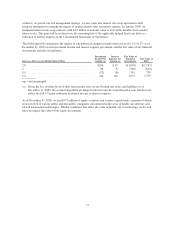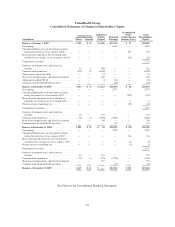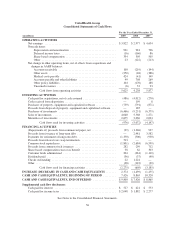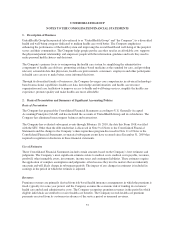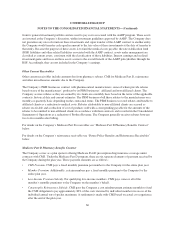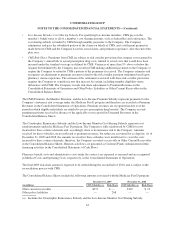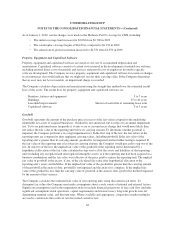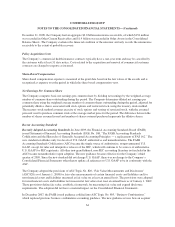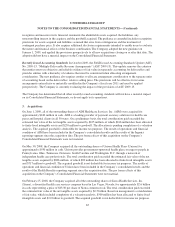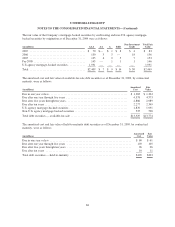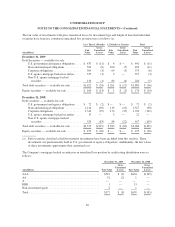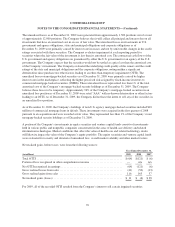United Healthcare 2009 Annual Report Download - page 62
Download and view the complete annual report
Please find page 62 of the 2009 United Healthcare annual report below. You can navigate through the pages in the report by either clicking on the pages listed below, or by using the keyword search tool below to find specific information within the annual report.UNITEDHEALTH GROUP
NOTES TO THE CONSOLIDATED FINANCIAL STATEMENTS—(Continued)
from its general investment portfolio and are used to pay costs associated with the AARP program. These assets
are invested at the Company’s discretion, within investment guidelines approved by AARP. The Company does
not guarantee any rates of return on these investments and, upon transfer of the AARP contract to another entity,
the Company would transfer cash equal in amount to the fair value of these investments at the date of transfer to
that entity. Because the purpose of these assets is to fund the medical costs payable, the rate stabilization fund
(RSF) liabilities and other related liabilities associated with the AARP contract, assets under management are
classified as current assets, consistent with the classification of these liabilities. Interest earnings and realized
investment gains and losses on these assets accrue to the overall benefit of the AARP policyholders through the
RSF. Accordingly, they are not included in the Company’s earnings.
Other Current Receivables
Other current receivables include amounts due from pharmacy rebates, CMS for Medicare Part D, reinsurance
and other miscellaneous amounts due to the Company.
The Company’s PBM businesses contract with pharmaceutical manufacturers, some of whom provide rebates
based on use of the manufacturers’ products by its PBM businesses’ affiliated and non-affiliated clients. The
Company accrues rebates as they are earned by its clients on a monthly basis based on the terms of the applicable
contracts, historical data and current estimates. The PBM businesses bill these rebates to the manufacturers on a
monthly or quarterly basis depending on the contractual terms. The PBM businesses record rebates attributable to
affiliated clients as a reduction to medical costs. Rebates attributable to non-affiliated clients are accrued as
rebates receivable and a reduction of cost of products sold with a corresponding payable for the amounts of the
rebates to be remitted to non-affiliated clients in accordance with their contracts and recorded in the Consolidated
Statements of Operations as a reduction of Product Revenue. The Company generally receives rebates between
two to five months after billing.
For details on the Company’s Medicare Part D receivables see “Medicare Part D Pharmacy Benefits Contract”
below.
For details on the Company’s reinsurance receivable see “Future Policy Benefits and Reinsurance Receivables”
below.
Medicare Part D Pharmacy Benefits Contract
The Company serves as a plan sponsor offering Medicare Part D prescription drug insurance coverage under
contracts with CMS. Under the Medicare Part D program, there are six separate elements of payment received by
the Company during the plan year. These payment elements are as follows:
•CMS Premium. CMS pays a fixed monthly premium per member to the Company for the entire plan year.
•Member Premium. Additionally, certain members pay a fixed monthly premium to the Company for the
entire plan year.
•Low-Income Premium Subsidy. For qualifying low-income members, CMS pays some or all of the
member’s monthly premiums to the Company on the member’s behalf.
•Catastrophic Reinsurance Subsidy. CMS pays the Company a cost reimbursement estimate monthly to fund
the CMS obligation to pay approximately 80% of the costs incurred by individual members in excess of the
individual annual out-of-pocket maximum. A settlement is made with CMS based on actual cost experience,
after the end of the plan year.
60



